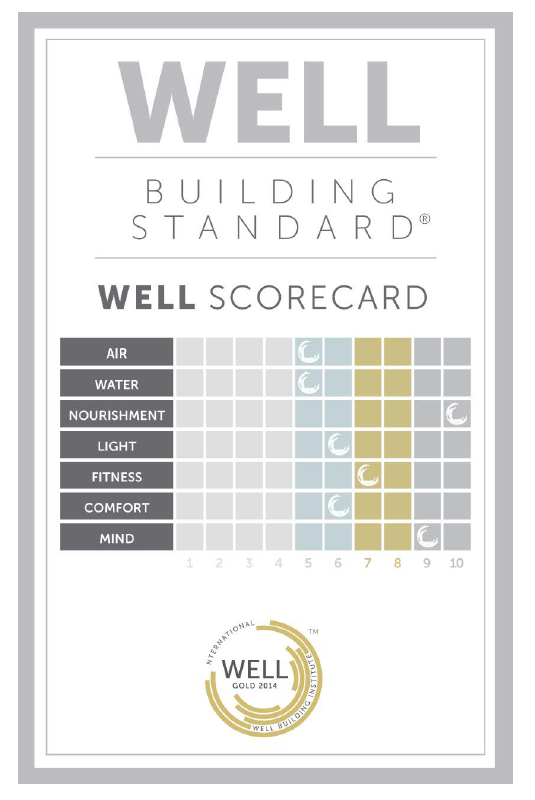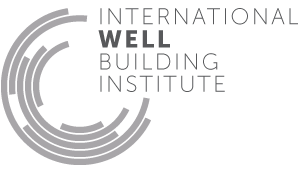WELL Certification
Projects may achieve WELL Certification at the Silver, Gold, or Platinum level if a sufficient number of Features are met. To maintain WELL Certification, spaces must be recertified a minimum of every three years. Three years is considered the maximum timeframe allowed before recertification is required because building conditions can deteriorate over time to the point of adversely affecting the health and wellness of occupants. The process for WELL Certification and WELL Compliance is summarized below.
Project Registration
Projects seeking to achieve the WELL Building Standard must register with the IWBI through WELL Online, IWBI’s web platform for managing the WELL Certification process. Project teams may register at any point as they progress through the design and development process. However, it is advantageous to register as close to the beginning of the process as possible so that strategies to meet the WELL Building Standard can be integrated from the very beginning.
WELL Accredited Professionals
The breadth of the WELL Building Standard encompasses knowledge across several disciplines, from both theoretical and applied standpoints. The IWBI will launch the WELL Accredited Professional (WELL AP) program in early 2015. Currently, project teams have the option to engage Provisional WELL APs as consultants. Provisional WELL APs are accredited professionals in the building industry who are trained on the conceptual and applied frameworks of the WELL Building Standard and experienced in its application on registered and certified WELL projects.
Documentation Process and Project Adherence
While the WELL Building Standard is based largely upon performance to measurable criteria, demonstrating adherence to WELL also requires detailed documentation to verify that certain Features have been met. The project team will be required to submit certain requested documents, including annotated documents and letters of assurance, to demonstrate adherence to Features being pursued.
WELL Commissioning
WELL Commissioning ensures that the building is performing as intended and can help to maintain and improve its level of performance over time. WELL Commissioning is completed by an authorized assessor who will spend approximately one to three days in the building to validate the project’s design documentation and to complete a series of performance tests that focus on air, water and lighting quality. Testing is completed according to IWBI’s sampling protocols based on the size and type of the project, and samples are sent to a third-party lab for analysis.
If the project meets all performance requirements, it is ready to submit for final certification. If the project is not performing in specific areas, the project team is given an opportunity to identify the cause and make the necessary corrections. In assessing adherence, a project’s WELL Building Standard assessor will grade each Concept independently from other Concepts on a numerical scale. Failure to achieve all applicable Preconditions in any Concept will preclude an award of WELL Certification or WELL Core and Shell Compliance. Once all applicable Preconditions have been achieved, higher levels of certification are possible. In evaluating award levels, all Optimization Features are treated equally.
All WELL Features are subject to verification on-site by an assessor during WELL Commissioning—even those accounted for by letters of assurance or annotated documents. The assessor may therefore provide additional documentation for final certification in the form of an inspection document.
Scoring
Concept scores and the final wellness score are calculated based on the following algorithm for the number of WELL Features applicable to a specific typology:
Total Preconditions = TP
Preconditions Achieved = PA
Total Optimizations = TO
Optimizations Achieved = OA
FAIL: IF (PA/TP) < 1 THEN Wellness Score = (PA / TP) * 5 (rounded down to the nearest whole number)
PASS: IF (PA/TP) = 1 THEN Wellness Score = 5 + (OA /TO)* 5 (rounded down to the nearest whole number)
The example below shows an office that successfully meets the requirements of the WELL Building Standard as applied to the New Construction typology. With all Preconditions met and 29 Optimizations met, it will receive the Concept Scores calculated below and a final Wellness Score of 7 (with rounding applied).
| CONCEPT | PRECONDITIONS | OPTIMIZATIONS | WELLNESS SCORE | ||
|---|---|---|---|---|---|
| APPLICABLE | ACHIEVED | APPLICABLE | ACHIEVED | ||
| Air | 12 | 12 | 17 | 3 | 5.9 |
| Water | 5 | 5 | 3 | 0 | 5.0 |
| Nourishment | 8 | 8 | 7 | 7 | 10.0 |
| Light | 4 | 4 | 7 | 2 | 6.4 |
| Fitness | 2 | 2 | 6 | 3 | 7.5 |
| Comfort | 5 | 5 | 7 | 2 | 6.4 |
| Mind | 5 | 5 | 14 | 12 | 9.3 |
| Total | 41 | 41 | 61 | 29 | 7.4 |
| Final Wellness Score: | 7 | ||||
Based on these calculations, a score would be displayed per Concept on a scale such as the one for Water shown below. The scale below reflects a Concept Score of 5 with all Precondition Features in Water having been satisfied.

Lower scores (0 – 4) comprise the compulsory Precondition Features; a score less than 5 would denote failure to meet the Preconditions in that Concept and thus a failure for overall certification or compliance. Silver scores (5 – 6) mean that all compulsory Precondition Features have been met in the Concept. Gold scores (7 – 8), and Platinum scores (9 – 10) comprise the non-compulsory optimizations.
WELL Certification
WELL Certified projects meet a score of at least 5 for all WELL Concepts, meaning that they have met all Preconditions. To achieve a higher score, projects must pursue Optimization Features. Because health and wellness objectives vary from one building to the next, the WELL Building Standard provides flexibility by weighing all Optimization equally, enabling project teams to select the Optimizations that best suit the intended health interventions of their project.
The image below shows the aggregate score for the example above, yielding Gold level certification.

- Silver level certification is achieved by meeting 100% of the Preconditions applicable to the typology (a Wellness Score of 5 or 6).
- Gold level certification is achieved by meeting 100% of the Preconditions applicable to the typology, as well as 40% or more of the Optimizations overall (a Wellness Score of 7 or 8).
- Platinum level certification is achieved by meeting 100% of the Preconditions applicable to the typology, as well as 80% or more of the Optimizations overall (a Wellness Score of 9 or 10).
WELL Scorecard
The WELL Scorecard is the aggregate of all of the Wellness Scales for each Concept. The scorecard shows Gold level certification for the building example above:

Well Compliance for Core and Shell
WELL Core and Shell Compliant projects must achieve a score of at least 5 for all WELL Concepts, meaning that they have met all Preconditions and one Optimization of their choice from each Concept.
Recertification Requirements
WELL Certification is valid for three years from the date of the certification award letter. In order to maintain certification after that time, a project must be re-commissioned and apply for recertification to verify that the building continues to perform to the WELL Building Standard. During recertification, projects may submit evidence of achievement of additional Features to improve their score or achieve a higher level of certification. Project scores may drop if WELL Features have not been properly maintained since initial certification, and certification will be revoked if the quality of the interior environment has declined below the thresholds required in the WELL Building Standard.
Recertification is not available for WELL Core and Shell Compliance because WELL Core and Shell Compliance is a one-time determination that, as of the date of the award, a project has a achieved all applicable requirements of the WELL Building Standard as applied to the core and shell of a building.
